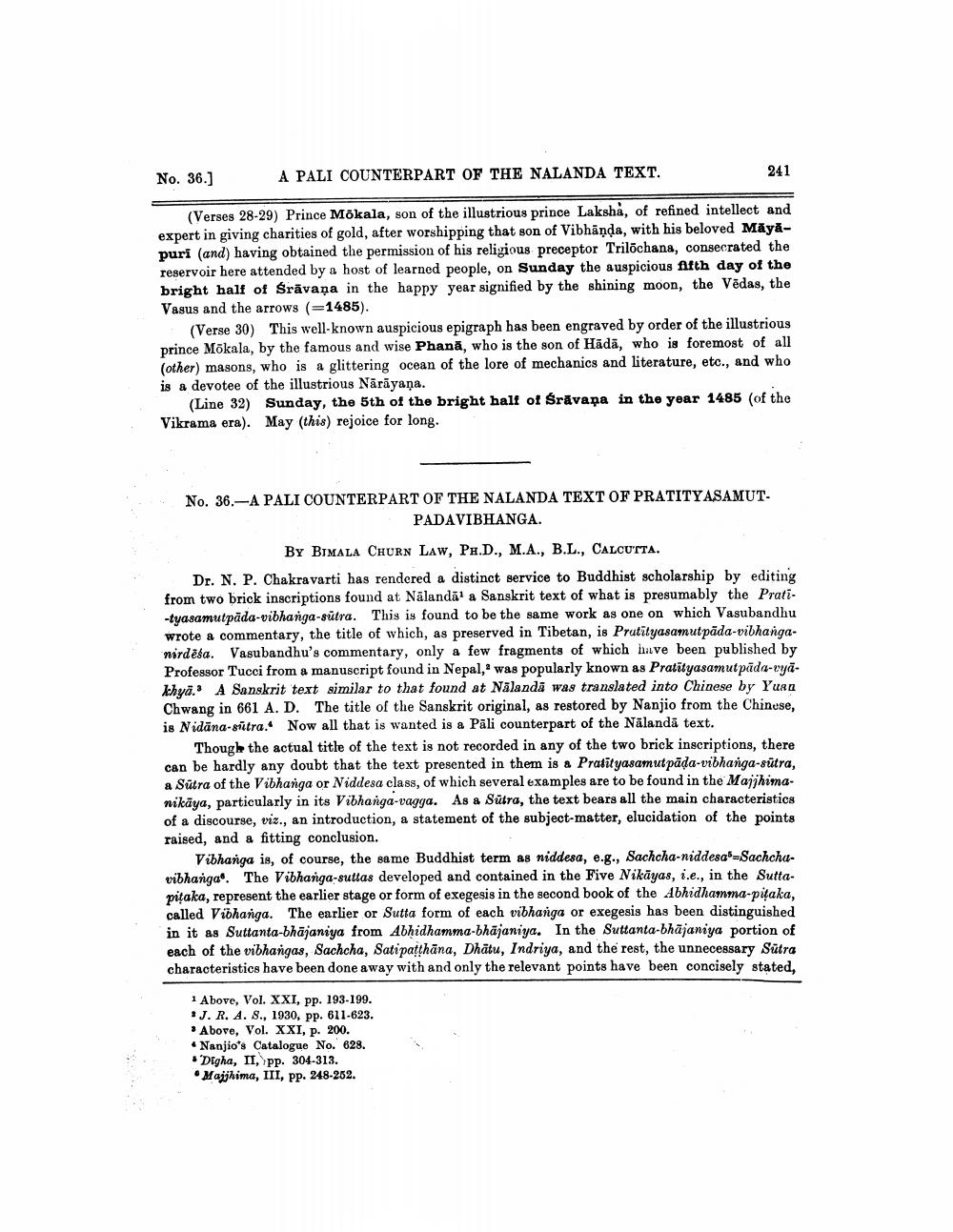________________
No. 36.]
A PALI COUNTERPART OF THE NALANDA TEXT.
241
(Verses 28-29) Prince Mokala, son of the illustrious prince Lakshà, of refined intellect and expert in giving charities of gold, after worshipping that son of Vibhända, with his beloved Mayapuri (and) having obtained the permission of his religious preceptor Trilochana, consecrated the reservoir here attended by a host of learned people, on Sunday the auspicious fifth day of the bright half of Srāvana in the happy year signified by the shining moon, the Vēdas, the Vasus and the arrows (=1485).
(Verse 30) This well-known auspicious epigraph has been engraved by order of the illustrious prince Mõkala, by the famous and wise Phanā, who is the son of Hādā, who is foremost of all (other) masons, who is a glittering ocean of the lore of mechanics and literature, etc., and who is a devotee of the illustrious Nārāyana.
(Line 32) Sunday, the 5th of the bright half of Srāvana in the year 1485 (of the Vikrama era). May (this) rejoice for long.
No. 36.-A PALI COUNTERPART OF THE NALANDA TEXT OF PRATITYASAMUT
PADAVIBHANGA.
BY BIMALA CHURN LAW, Ph.D., M.A., B.L., CALCUTTA. Dr. N. P. Chakravarti has rendered a distinct service to Buddhist scholarship by editing from two brick inscriptions found at Nālandāt a Sanskrit text of what is presumably the Pratityasamutpäda-vibhanga-sutra. This is found to be the same work as one on which Vasubandhu wrote a commentary, the title of which, as preserved in Tibetan, is Prutityasamutpäda-vibhangawirdēsa. Vasubandhu's commentary, only a few fragments of which have been published by Professor Tucci from a manuscript found in Nepal, was popularly known as Pratityasamutpūda-cyā. khya. A Sanskrit text similar to that found at Nalanda was translated into Chinese by Yuan Chwang in 661 A. D. The title of the Sanskrit original, as restored by Nanjio from the Chinese, is Nidāna-sitra. Now all that is wanted is a Pāli counterpart of the Nālandā text.
Though the actual title of the text is not recorded in any of the two brick inscriptions, there can be hardly any doubt that the text presented in them is & Pratītyasamut pāda-vibhanga-sútra, a Sutra of the Vibhanga or Niddesa class, of which several examples are to be found in the Majjhimanikāya, particularly in its Vibhanga-vagga. As a Sūtra, the text bears all the main characteristics of a discourse, viz., an introduction, a statement of the subject matter, elucidation of the points raised, and a fitting conclusion.
Vibhanga is, of course, the same Buddhist term as niddesa, e.g., Sachcha-niddesa -Sachchavibhanga. The Vibhanga-suttas developed and contained in the Five Nikāyas, i.e., in the Suttapitaka, represent the earlier stage or form of exegesis in the second book of the Abhidhamma-pitaka, called Vibhanga. The earlier or Sutta form of each vibhanga or exegesis has been distinguished in it as Suttanta-bhäjaniya from Abhidhamma-bhājaniya. In the Suttanta-bhājaniya portion of each of the vibhangas, Sachcha, Satipatthāna, Dhātu, Indriya, and the rest, the unnecessary Sütra characteristics have been done away with and only the relevant points have been concisely stated,
1 Above, Vol. XXI, pp. 193-199. * J. R. A. 8., 1930, pp. 611-623.
Above, Vol. XXI, p. 200. • Nanjio's Catalogue No. 628. .Digha, II, pp. 304-313. Majjhima, III, pp. 248-252.




